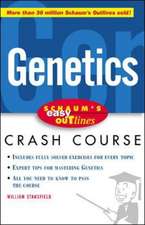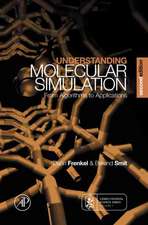Genetics 101: Science 101
Autor Michael Windelspechten Limba Engleză Hardback – 29 mai 2007 – vârsta până la 17 ani
Preț: 226.87 lei
Preț vechi: 391.76 lei
-42% Nou
Puncte Express: 340
Preț estimativ în valută:
43.42€ • 45.16$ • 35.84£
43.42€ • 45.16$ • 35.84£
Carte tipărită la comandă
Livrare economică 15-29 aprilie
Preluare comenzi: 021 569.72.76
Specificații
ISBN-13: 9780313333811
ISBN-10: 0313333815
Pagini: 216
Dimensiuni: 156 x 235 x 21 mm
Greutate: 0.47 kg
Editura: Bloomsbury Publishing
Colecția Greenwood
Seria Science 101
Locul publicării:New York, United States
ISBN-10: 0313333815
Pagini: 216
Dimensiuni: 156 x 235 x 21 mm
Greutate: 0.47 kg
Editura: Bloomsbury Publishing
Colecția Greenwood
Seria Science 101
Locul publicării:New York, United States
Notă biografică
Michael Windelspecht is Assistant Professor of Biology at Appalachian State University. He is the author or co-author of numerous works for Greenwood, including The Digestive System and The Lymphatic System in the Human Body Systems series.
Recenzii
Windelspecht begins this comprehensive overview with the early history of genetics, focusing primarily on the experiments of Gregor Mendel in the 19th century and Thomas Hunt Morgan in the early 20th. Subsequent chapters build on readers increasing understanding of the material, expertly cross-referencing information explained earlier..The title covers hot topics like gene therapy, including the use of viral vectors, enzyme replacement, and germ line therapy; it also discusses DNA fingerprinting and genetic engineering, and briefly touches on stem cells. The black-and-white illustrations are helpful in explaining mathematical concepts or experimental procedures.
This clear, concise book describes basic concepts in genetics from a wide variety of subfields, including classic genetics, molecular biology, and their applications and related techniques..I recommend this volume to anyone without a scientific background who is interested in learning not only the basic jargon of the discipline of genetics, but also how the scientific method works.
In this volume meant for students and general readers, Windelsprecht discusses genetics, explaining how scientists determined that traits are coded by the gene. It is meant as a reference source for general information on genetics for those who are not scientists and is therefore, not comprehensive. He begins with a history of genetics before the nineteenth century, details how scientists determined that DNA contains genes, and describes genetic structure. How the gene is studied, molecular genetics, and cloning are discussed in subsequent chapters, followed by mutation and chromosomal abnormalities and recent developments such as gene manipulation and therapy, RNA interference, DNA typing, and work with stem cells.
While the work of Gregor Mendel in the 19th century focused interest in genetics, implementation of genetics has been in practice (although it didnt have a name) from ancient civilizations when farmers wanted better animals and plants. Genetics, the study of inheritance, is often put to use in a couples predicting the color of eyes their baby might have. Interest also has been increased with the constant reference to DNA in the various CSI adventures on television. The foreword has a list of abbreviations..Black and white drawings and figures illustrate the text. Appendixes include a 10-page glossary and a 5-page bibliography of print and Web resources. Because we find the study of DNA, gene, and genome in science classes, this is an excellent resource. It also will be useful in the debate about cloning, and it will help the reader understand why a prediction about a babys eyes may not be accurate.
Using simple direct text and by carefully explaining the essential vocabulary of genetics, this volume manages to cover the principal themes comprising genetics..[t]he objective is to provide interested readers with a general idea of the basis of the science of genetics, the key components that make up the hereditary material and how this knowledge is being used to advance our understanding of life. For a reader with a background in basic biology, this serves as a competent resource to give the nonspecialist a summary of the discipline.
This clear, concise book describes basic concepts in genetics from a wide variety of subfields, including classic genetics, molecular biology, and their applications and related techniques..I recommend this volume to anyone without a scientific background who is interested in learning not only the basic jargon of the discipline of genetics, but also how the scientific method works.
In this volume meant for students and general readers, Windelsprecht discusses genetics, explaining how scientists determined that traits are coded by the gene. It is meant as a reference source for general information on genetics for those who are not scientists and is therefore, not comprehensive. He begins with a history of genetics before the nineteenth century, details how scientists determined that DNA contains genes, and describes genetic structure. How the gene is studied, molecular genetics, and cloning are discussed in subsequent chapters, followed by mutation and chromosomal abnormalities and recent developments such as gene manipulation and therapy, RNA interference, DNA typing, and work with stem cells.
While the work of Gregor Mendel in the 19th century focused interest in genetics, implementation of genetics has been in practice (although it didnt have a name) from ancient civilizations when farmers wanted better animals and plants. Genetics, the study of inheritance, is often put to use in a couples predicting the color of eyes their baby might have. Interest also has been increased with the constant reference to DNA in the various CSI adventures on television. The foreword has a list of abbreviations..Black and white drawings and figures illustrate the text. Appendixes include a 10-page glossary and a 5-page bibliography of print and Web resources. Because we find the study of DNA, gene, and genome in science classes, this is an excellent resource. It also will be useful in the debate about cloning, and it will help the reader understand why a prediction about a babys eyes may not be accurate.
Using simple direct text and by carefully explaining the essential vocabulary of genetics, this volume manages to cover the principal themes comprising genetics..[t]he objective is to provide interested readers with a general idea of the basis of the science of genetics, the key components that make up the hereditary material and how this knowledge is being used to advance our understanding of life. For a reader with a background in basic biology, this serves as a competent resource to give the nonspecialist a summary of the discipline.






















